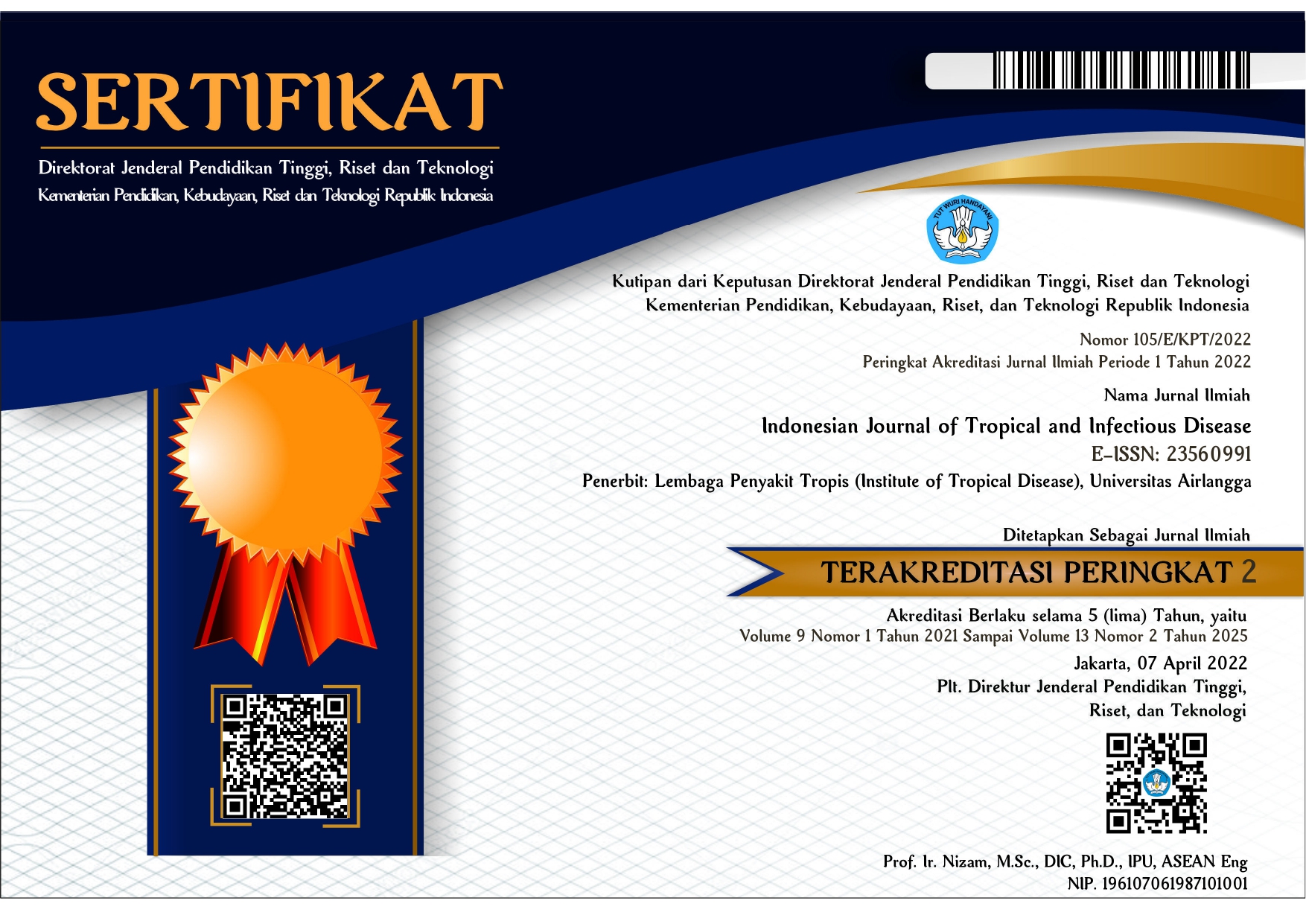Synthesis and Characterization of Cu(II)-EDTA Complexes: Antibacterial Studies (Escherichia coli, Staphylococcus aureus) and Inhibition of Dengue Virus Serotype 2 in Vero Cell
Downloads
The Cu(II)-EDTA complex is known to have antibacterial and antiviral potential, but its effectiveness against pathogenic bacteria and dengue virus serotype 2 (DENV-2) still needs to be studied. This study synthesized and characterized the Cu(II)-EDTA complex of CuSO4 precursors, and then tested the antibacterial activity against Escherichia coli and Staphylococcus aureus, as well as the antiviral activity against DENV-2 in Vero cells. This study successfully synthesized and characterized the Cu(II)-EDTA complex using CuSO4 as a precursor through the solvothermal method, producing blue crystals with a Cu ratio of 1:1. DSC analysis showed thermal stability up to 250°C with an endothermal peak at 270-300°C. The particles are 6.31 nm in size with a PDI of 0.076, indicating uniform distribution with nanoparticle size (<100 nm). FTIR confirms the formation of the complex through significant shifts in the O-H and C=O bands. SEM shows a layered morphology that can affect the solubility and release of substances. UV-Vis shows maximum absorbance peaks of EDTA at 244 nm and CuSO4 at 740 nm. Antibacterial tests of Cu(II)-EDTA against E. coli and S. aureus showed that Cu(II)-EDTA had less activity than pure CuSO4. For DENV-2, CuSO4 was more effective with an EC50 value of 77.86 μg/mL, lower than Cu(II)-EDTA 356.13 μg/mL, indicating that CuSO4 was better at inhibiting viral replication.
Kaushik S, Dar L, Kaushik S, Yadav JP. Identification and characterization of new potent inhibitors of dengue virus NS5 proteinase from Andrographis paniculata supercritical extracts on in animal cell culture and in silico approaches. J. Ethnopharmacol 2021;267: 113541
World Health Organization. Dengue Global Situation. https://www.who.int/emergencies/ disease-outbreak-news/item/2023 DON498 (2023).
Zerfu B, Kassa T. Legesse M. Epidemiology, biology, pathogenesis, clinical manifestations, and diagnosis of dengue virus infection, and its trend in Ethiopia: a comprehensive literature review. Trop. Med. Health 2023;5(1):11.
Amorim MT, Hernández LHA, Naveca FG, Prazeres ITE, Wanzeller ALM, da Silva EVP, Casseb LMN, da Silva FS, da Silva SP, Nunes BTD, Cruz ACR. Emergence of a New Strain of DENV-2 in South America: Introduction of the Cosmopolitan Genotype through the BrazilianPeruvian Border. Trop. Med. Infect. Dis. 2023;8(6): 325.
Salah I, Parkin IP, Allan E. Copper as an antimicrobial agent: Recent advances. RSC Adv. 2021;11(30): 18179–18186.
Sucipto TH, Martak F. Synthesis of Metal-Organic (Complexes) Compounds Copper(Ii)-Imidazole for Antiviral Hiv Candidate. Indones. J. Trop. Infect. Dis. 2016;6(1): 5-11.
Li M, Tang S, Velkov T, Shen J, Dai C. Copper exposure induces mitochondrial dysfunction and hepatotoxicity via the induction of oxidative stress and PERK/ATF4 - mediated endoplasmic reticulum stress. Env Poll 2024;352: 124145.
Sucipto TH, Martak F. Inhibition of dengue virus serotype 2 in Vero cells with [Cu(2,4,5- triphenyl-1Himidazole)2H2O)2].Cl2. Infect. Dis. Rep. 2020;12(Suppl 1), 8744.
Bachir G, Abouni B. Escherichia coli and Staphylococcus aureus most common source of infection. Battle Against Microb. Pathog. Basic Sci 2015;2: 637–48. 10. Nguyen TN, Do QH, Vu TTD, Nguyen TT, Nguyen DT, Nguyen TBN, Tran TTH, Vu TKO, Nghiem THL, Hoa TMT, Nguyen TMH, Bui PN, Nguyen MH, Pham DM, Tran TCT. Enhancement of antibacterial activity by a copper(II) and zinc(II) in chelation with ethylenediaminetetra-acetic acid and urea complex. Chem. Pap 2022;76: 7163–7176
Finnegan S, Percival SL. EDTA: An Antimicrobial and Antibiofilm Agent for Use in Wound Care. Adv. Wound Care 2015;4: 415– 421.
Sucipto TH Churrotin S, Setyawati H, Martak F, Mulyatno KC, Amarullah IH, Kotaki T, Kamoeka M, Yotopranoto S, Soegijnato S. A new copper (II)- imidazole derivative effectively inhibits replication of denv-2 in vero cell. African J. Infect. Dis. 2018;12(1 Suppl): 116-119.
Khan SA, Asiri AM. Multi-step synthesis, spectroscopic studies of biological active steroidal thiosemicarbazones and their palladium (II) complex as macromolecules. Int. J. Biol. Macromol 2018;107(Pt A): 105–111.
Sucipto TH, Setyawati H, Churrotin S, Amarullah IH, Sumarsih S, Wardhani P, Aryati, Soegijanto S. Anti-Dengue Type 2 Virus Activities of Zinc (II) Complex Compounds With 2-(2,4 - Dihydroxyphenyl)-3,5,7- Trihydroxycromen-4-One Ligands in Vero Cells. Indones. J. Trop. Infect. Dis 2019;7(5):105-108.
Rahban M, Ahmad F, Piatyszek MA, Haertlé T, Saso L, Saboury AA. Stabilization challenges and aggregation in protein-based therapeutics in the pharmaceutical industry. RSC Adv 2023;13(51); 35947–35963.
Asean Guideline. Asean Guideline On Stability of Drug Product. Asean Main Portal. 2018. Available: https://asean.org/wpcontent/uploads/i-Final-ASEANGuideline-on-Stability-Study-DrugProduct-R2_uniformedtemplate.pdf.
Pérez-Díaz MA, Boegle L, James G, Velasquillo C, SánchezSánchez R, Martínez-Martínez, Martínez-Castañón GJ, MartínezGutierrez F. Silver nanoparticles with antimicrobial activities against Streptococcus mutans and their cytotoxic effect. Mater. Sci. Eng. C 2015;55, 360–366.
Teulon JM, Godon C, Chantalat L, Moriscot C, Cambedouzou J, Odorico M, Ravaux J, Podor R, Gerdil A, Habert A, Herlin-Boime N, Chen SW, Pellequer JL. On the Operational Aspects of Measuring Nanoparticle Sizes. Nano 2019;9(1):18.
Mohapatra S, Bhakuni PR, Barman S, Nayak B. RSM-CCD optimized hollow mesoporous silica nanospheres encapsulating sorafenib induce mitochondrial membrane potential mediated apoptotic cell death in non-small cell lung cancer. Microporous Mesoporous Mater 2024;370: 113032.
Shen CH. Chapter 7 - Quantification and analysis of nucleic acids. in Diagnostic Molecular Biology (Second Edition) (ed. Shen, C.-H.) 181–208 (Academic Press, 2023). doi:https://doi.org/10.1016/B978-0- 323-91788-9.00018-1.
Hernández-López A, Félix DAS, Sierra ZZ, Bravo IG, Dinkova TD, Avila-Alejandre A. Quantification of reducing sugars based on the qualitative technique of Benedict. ACS Omega 2020;5(50): 32403–32410.
Bentancor A, Blanco CX, Piccini C, Trueba G. New Concepts on Domestic and Wild Reservoirs and Transmission of E. coli and Its
Environment. Spring Int Pub 2023. Available: https://link.springer.com/chapter/10.1007/978-3-031-29882-0_3
Sada TS, Tessema TS. Isolation and characterization of lytic bacteriophages from various sources in Addis Ababa against antimicrobial-resistant diarrheagenic Escherichia coli strains and evaluation of their therapeutic potential. BMC Infect Dis 2024;24:310.
Meenakshi, Pawar S, Shivhare B, Sharma A, Prabhu S, Awasthi S. Nano-biotechnological approach for the ultrasensitive electrochemical and fluorescence detection of Staphylococcal enterotoxin B. Mater Res Express 2025;12(3):032001.
Alkuraythi DM, Alkhulaifi MM, Binjomah AZ, Alarwi M, Mujallad MI, Alharbi SA, Alshomrani M, Gojobori T, Alajel SM. Comparative genomic analysis of antibiotic resistance and virulence genes in Staphylococcus aureus isolates from patients and retail meat. Front cell infect microbiol 2024;13:1339339.
Tsuneo I. Anti-Bacterial Mechanism for Metallic Ag+,Cu2+, Zn2+ Ions-Induced Bactertiolysis on Disruptive OM Lpp and PGN Inhibitive Elongations Against S. aureus and E. coli. Mathews J. Cytol. Histol 2022;6:1–13.
Copyright (c) 2025 Indonesian Journal of Tropical and Infectious Disease

This work is licensed under a Creative Commons Attribution-NonCommercial-ShareAlike 4.0 International License.
The Indonesian Journal of Tropical and Infectious Disease (IJTID) is a scientific peer-reviewed journal freely available to be accessed, downloaded, and used for research. All articles published in the IJTID are licensed under the Creative Commons Attribution-NonCommercial-ShareAlike 4.0 International License, which is under the following terms:
Attribution ” You must give appropriate credit, link to the license, and indicate if changes were made. You may do so reasonably, but not in any way that suggests the licensor endorses you or your use.
NonCommercial ” You may not use the material for commercial purposes.
ShareAlike ” If you remix, transform, or build upon the material, you must distribute your contributions under the same license as the original.
No additional restrictions ” You may not apply legal terms or technological measures that legally restrict others from doing anything the license permits.























